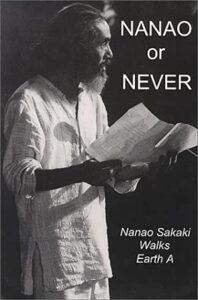
Nanao Sakaki (1923-2008) was not a Kyoto writer, but a wandering poet who belonged to everywhere and nowhere. By all accounts he led a remarkable life and wrote remarkable poems. Some folks in Kyoto had the pleasure to know him, particularly Ken Rodgers who accompanied him on a tour to Australia. Thanks to Ken for supplying the piece below by Robert Lee, which first appeared in the Kyoto Journal.
*****************************
Extracted from Robert Lee’s tribute to Nanao Sakaki ‘Transnational Poet Wanderer’ in Kyoto Journal, no. 78, p.127ff;
There was the first meeting with Snyder and Ginsberg in Kyoto in 1963 and then Snyder’s invitation to him to visit America in 1968 (California and the West Coast of mountain and ocean, Manhattan and Greenwich Village). Subsequent visits include poetry readings with Waldman, Ginsberg, and others, notably at Naropa in 1981. In June 1988 he asked Ginsberg, Snyder, McClure and Waldman for help in raising money to protect the blue coral reef in Ishigaki-jima against becoming a new airport landing-strip. Their poetry reading in San Francisco served as publicity and a fund-raiser. Sakaki’s message to this Beat consortium he included in his Japanese collection CHIKYU B (1989), with a translation into English under the title “Save Shiraho’s Coral Reef” in Nanao or Never (“this Kamikaze project” he calls the planned landing strip).
In an interview with Trevor Carolan, Sakaki explained very succinctly what kind of Zen he adheres to: “ Most Zen is uninteresting to me …It’s too linked to the samurai tradition – to militarism. This is where Alan Watts and I disagreed: he didn’t fully understand how the samurai class with whom he associated Zen were in fact deeply Confucian: they were concerned with power. The Zen I’m interested in is China’s Tang dynasty variant with teachers like Lin Chi. This was non-intellectual. It came from farmers—so simple. Someone became enlightened, others talked to him, learned and were told, Now you go there and teach; you go here, etc. When Japan tried to study this it was hopeless, the emperor sent scholars, but with their high-flown language and ideas they couldn’t understand.” (Nanao or Never).
************************
The following is taken from this webpage.
Nanao’s reputation spread and in the sixties when Allen Ginsberg went to Kyoto to visit Gary Snyder, they were told they had to meet Nanao so they did and they all became fast friends and they invited him to go to America which he did. He spent about ten years in America – in San Francisco and New Mexico and in the mountains and desserts. A friend of mine who knows Nanao says that Nanao walked from New York to California and back and forth a number of times and up to Alaska and so forth. All the walking stories I’ve heard about Nanao seem to me to add up to more miles than one could cover in a lifetime. But whatever he’s walked, it’s been one whole heck of a lot.
Folks at the SF Zen Center got to know Nanao because he never had a place of his own or any money so one of the communal houses near Zen Center would take him in as an honored guest. But he just wrote poetry and philosophized and didn’t tend to do the dishes so, after a while, he’d be passed on to another Zen Center house or hippy commune. And he’d write poetry and publish books and go to events like be-ins and concerts. He didn’t always get his way. Kyokes in Kyoto was working at an environmental center on Yoshida mountain by the Yoshida shrine on the West side of the city – the same place where landscaper and Nanao buddy Sogyu is now. They were running a little hostel there a few years ago at quite reasonable rates and Nanao showed up and wanted a room for free and thought his name would do for legal tender but she said he’d have to pay like everyone else so he went off and found somewhere else.
“His poems were not written by hand or head, but with the feet. These poems have been sat into existence, walked into existence, to be left here as traces of a life lived for living…”
Gary Snyder, Foreword, Break the Mirror
If you have time to chatter
Read books
If you have time to read
Walk into mountain, desert and ocean
If you have time to walk
sing songs and dance
If you have time to dance
Sit quietly, you Happy Lucky Idiot
[ Kyoto, 1966]
(The below is an oral transcription of Nanao put into poetic form by Steve Brooks)
ENVIRONMENTAL CASE: NUCLEAR POWER PLANTS AND EARTHQUAKES IN JAPAN
Fifteen nuclear power plants north of Kyoto, I visit there
many times
I stay at Shingon or Zen temples that are anti-nuke.
Mostly Japanese Buddhists very conservative, they never
talk about nuclear power issue
but the monks at those temples shout, “no nukes, no nukes!”
Kyoto is so close to the plants, only 100 miles
and wind always blowing: Kyoto to Osaka to Kobe
Because of wind course if something happens millions of
people must die.
Already the government thinks 5 million will die if some-
thing happens to a power plant. Like an earthquake.
